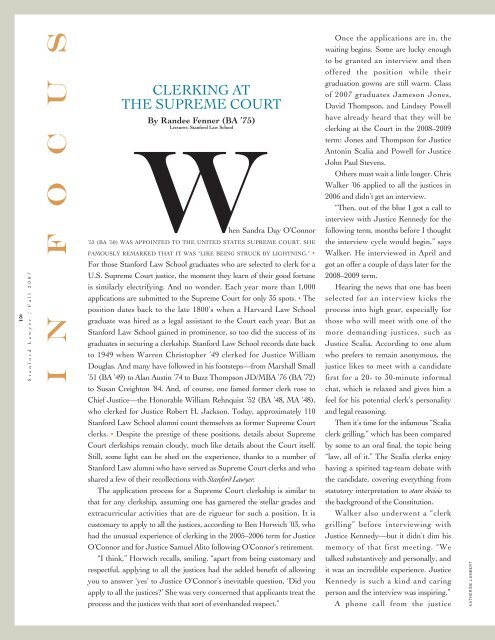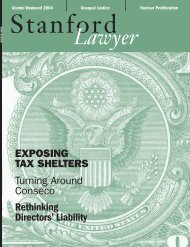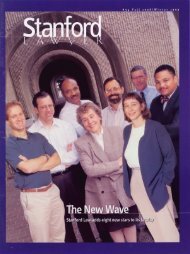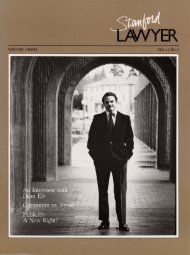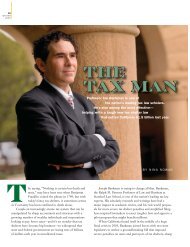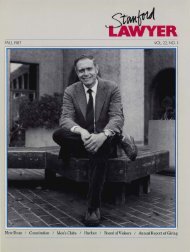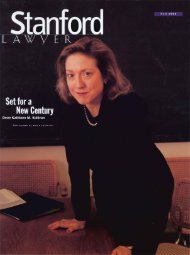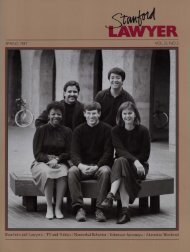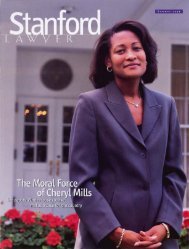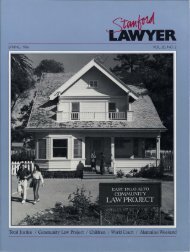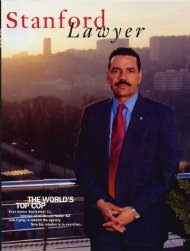Issue 77 - Stanford Lawyer - Stanford University
Issue 77 - Stanford Lawyer - Stanford University
Issue 77 - Stanford Lawyer - Stanford University
You also want an ePaper? Increase the reach of your titles
YUMPU automatically turns print PDFs into web optimized ePapers that Google loves.
8<br />
<strong>Stanford</strong> <strong>Lawyer</strong> / Fall 2007<br />
I N F O C U S<br />
CLERKING AT<br />
THE SUPREME COURT<br />
By Randee Fenner (BA ’75)<br />
Lecturer, <strong>Stanford</strong> Law School<br />
When<br />
Sandra Day O’Connor<br />
’52 (BA ’50) WAS APPOINTED TO THE UNITED STATES SUPREME COURT, SHE<br />
FAMOUSLY REMARKED THAT IT WAS “LIKE BEING STRUCK BY LIGHTNING.” •<br />
For those <strong>Stanford</strong> Law School graduates who are selected to clerk for a<br />
U.S. Supreme Court justice, the moment they learn of their good fortune<br />
is similarly electrifying. And no wonder. Each year more than 1,000<br />
applications are submitted to the Supreme Court for only 35 spots. • The<br />
position dates back to the late 1800’s when a Harvard Law School<br />
graduate was hired as a legal assistant to the Court each year. But as<br />
<strong>Stanford</strong> Law School gained in prominence, so too did the success of its<br />
graduates in securing a clerkship. <strong>Stanford</strong> Law School records date back<br />
to 1949 when Warren Christopher ’49 clerked for Justice William<br />
Douglas. And many have followed in his footsteps—from Marshall Small<br />
’51 (BA ’49) to Alan Austin ’74 to Buzz Thompson JD/MBA ’76 (BA ’72)<br />
to Susan Creighton ’84. And, of course, one famed former clerk rose to<br />
Chief Justice—the Honorable William Rehnquist ’52 (BA ’48, MA ’48),<br />
who clerked for Justice Robert H. Jackson. Today, approximately 110<br />
<strong>Stanford</strong> Law School alumni count themselves as former Supreme Court<br />
clerks. • Despite the prestige of these positions, details about Supreme<br />
Court clerkships remain cloudy, much like details about the Court itself.<br />
Still, some light can be shed on the experience, thanks to a number of<br />
<strong>Stanford</strong> Law alumni who have served as Supreme Court clerks and who<br />
shared a few of their recollections with <strong>Stanford</strong> <strong>Lawyer</strong>.<br />
The application process for a Supreme Court clerkship is similar to<br />
that for any clerkship, assuming one has garnered the stellar grades and<br />
extracurricular activities that are de rigueur for such a position. It is<br />
customary to apply to all the justices, according to Ben Horwich ’03, who<br />
had the unusual experience of clerking in the 2005–2006 term for Justice<br />
O’Connor and for Justice Samuel Alito following O’Connor’s retirement.<br />
“I think,” Horwich recalls, smiling, “apart from being customary and<br />
respectful, applying to all the justices had the added benefit of allowing<br />
you to answer ‘yes’ to Justice O’Connor’s inevitable question, ‘Did you<br />
apply to all the justices?’ She was very concerned that applicants treat the<br />
process and the justices with that sort of evenhanded respect.”<br />
Once the applications are in, the<br />
waiting begins. Some are lucky enough<br />
to be granted an interview and then<br />
offered the position while their<br />
graduation gowns are still warm. Class<br />
of 2007 graduates Jameson Jones,<br />
David Thompson, and Lindsey Powell<br />
have already heard that they will be<br />
clerking at the Court in the 2008–2009<br />
term: Jones and Thompson for Justice<br />
Antonin Scalia and Powell for Justice<br />
John Paul Stevens.<br />
Others must wait a little longer. Chris<br />
Walker ’06 applied to all the justices in<br />
2006 and didn’t get an interview.<br />
“Then, out of the blue I got a call to<br />
interview with Justice Kennedy for the<br />
following term, months before I thought<br />
the interview cycle would begin,” says<br />
Walker. He interviewed in April and<br />
got an offer a couple of days later for the<br />
2008–2009 term.<br />
Hearing the news that one has been<br />
selected for an interview kicks the<br />
process into high gear, especially for<br />
those who will meet with one of the<br />
more demanding justices, such as<br />
Justice Scalia. According to one alum<br />
who prefers to remain anonymous, the<br />
justice likes to meet with a candidate<br />
first for a 20- to 30-minute informal<br />
chat, which is relaxed and gives him a<br />
feel for his potential clerk’s personality<br />
and legal reasoning.<br />
Then it’s time for the infamous “Scalia<br />
clerk grilling,” which has been compared<br />
by some to an oral final, the topic being<br />
“law, all of it.” The Scalia clerks enjoy<br />
having a spirited tag-team debate with<br />
the candidate, covering everything from<br />
statutory interpretation to stare decisis to<br />
the background of the Constitution.<br />
Walker also underwent a “clerk<br />
grilling” before interviewing with<br />
Justice Kennedy—but it didn’t dim his<br />
memory of that first meeting. “We<br />
talked substantively and personally, and<br />
it was an incredible experience. Justice<br />
Kennedy is such a kind and caring<br />
person and the interview was inspiring.”<br />
A phone call from the justice<br />
KATHERINE LAMBERT


